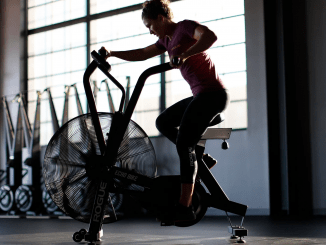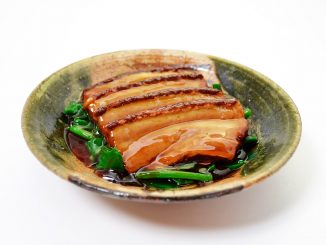What is the Paleo Diet?
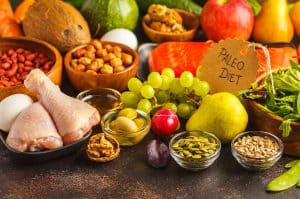
Today we’re going to talk about the Paleo diet – a nutritional strategy (and lifestyle) that claims to leverage our body’s evolutionary eating adaptations for maximum health.
The Paleo diet requires eating the foods our ancient ancestors ate and to avoid modern foods (and quantities) that aren’t compatible with our bodies. The core premise of the Paleo diet is that modern foods and diets have strayed too far from what our bodies and digestive systems have adapted to via tens of thousands of years of evolution.
Further, its proponents believe modern foods and the associated mismatch with our real dietary needs is the biggest driving factor behind the modern “diseases of civilization”: Type 2 Diabetes (Metabolic Syndrome), Parkinson’s Disease, autoimmune diseases, and some types of heart disease.
Also known as the “caveman diet”, the principles of Paleo eating were first popularized by Dr. Arthur De Vany (as the “evolutionary diet”). There isn’t one definitive, official “Paleo” diet. It has spawned numerous offshoots and variations, such as:
- Evolutionary diet
- Caveman diet
- Ancestral diet
- Hunter-Gatherer diet
- Primal diet
The core concept of paleo nutrition is that you should attempt to eat like your far ancient ancestors would have – and in a nutshell that means the following.
Eat:
- Lots of vegetables
- Meats (and all parts of the animal – such as organ meats)
- Seafood (fish, shrimp, shellfish, etc.)
- Nuts and seeds
- Mushrooms and other types of edible fungi
- Fruit (just watch the quantity – as too much fruit is too much sugar)
- Healthy, unrefined fats from both animals and plants
- Whole and natural foods – not processed foods
Avoid or eliminate:
- Grains
- Legumes
- Dairy
- Added sugars
- Processed foods
- Excess starches
- Alcohol
And as mentioned above – the quantities are important – your plate will on average be covered 2/3rds with vegetables! Paleo is a plant-based diet in that regard.
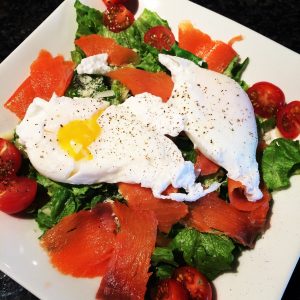
Why these restrictions? Let’s look at them one at a time.
The highly processed foods of our modern diet are awash in all the things Paleo recommends we avoid: grains (corn, wheat, etc.), vegetable oils, sugars, preservatives, and more. Check the ingredient label of any processed food item (such as a box of cereal, potato chips, or any snack food) that you have handy to confirm this.
Additionally, consumption of highly processed foods has been linked to a higher cancer risk via research studies.[1]
First of all, for our recommended foods: vegetables, fruits, meats, seafood, nuts, and seeds – you can see that these are all items that our hunter-gatherer ancestors would have eaten. It’s not difficult to imagine ancient humans gathering edible plants, nuts, and seeds, hunting wild game, and fishing. Modern farming and agriculture techniques arose about 10,000 years ago (in the “Neolithic” era) – and that’s a blink of the eye in evolutionary time frames. Therefore, the Paleolithic diet espouses avoiding many of the foods that have been popular since the advent of farming. First and foremost: Grains.
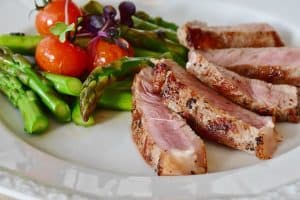
Grains such as wheat, oats, corn, and others are products of modern agriculture. These foods were not eaten by our caveman ancestors – they would not have been available in quantity, nor did they have the know-how of making them edible. Additionally, grains contain different compounds and proteins like gluten, lectins, and phytates, which may be the cause inflammation in the body and block other nutrients from being absorbed (and are therefore actually anti-nutrients). An extreme example of this is Celiac disease – a hypersensitivity to the gluten protein found in grains that triggers an autoimmune response from the body – the body’s own defenses attack itself. And while Celiac disease is believed to be a genetic disorder, and present in only 1% of the population, Paleo proponents claim that everyone has some level of sensitivity (and negative reaction) to grains. Therefore when following the paleo diet strictly – bread, pasta, breakfast cereals, and many other similar foods are off-limits.
It’s also possible to be successful by abiding by the core of the paleo principles and to stray outside the rules occasionally. Many are successful with the 80/20 rule: abiding by the paleo guidelines 80% of the time, and exercising restraint as best as possible when at social gatherings, traveling, or any other time that Paleo compliance isn’t possible. Perhaps the biggest advantage to Paleo eating and thinking: it builds a sense of awareness of your reaction to food types. Eliminate those things that have an adverse effect, and maximize those that don’t. Be aware of what you eat, and how it affects you.
The second negative aspect to grains: they supply an overabundance of carbohydrates in our diet. Paleo proponents argue that our hunter-gatherer ancestors existed on a relatively low level of carbs – natural sources of sugars and carbohydrates simply weren’t available – or were available only in very limited quantities (think of naturally harvested fruits – which would be available for only short periods of time, and certainly not in winter months). And as you’ve probably heard, the extreme amounts of carbohydrates in our modern diet is likely driving the sky-high rates of Type 2 Diabetes (insulin resistance – also known as Metabolic Syndrome) and other modern maladies such as heart disease.
The reasons for excluding legumes and dairy from the diet are similar. Both can potentially cause an allergic reaction in the body, and were not consumed in any significant quantities by our ancestors. Additionally, legumes contain the so-called anti-nutrients lectin and phytic acid. Our bodies can’t process these.
There are starchy food sources that aren’t problematic for most people – such as potatoes and rice. And while these aren’t problematic from a digestion and allergic reaction perspective, they do provide an easy way to get too much carbohydrate. Therefore, a strict paleo interpretation requires one to minimize intake of those foods.
Alcohol is undoubtedly empty calories, and few would argue otherwise. Generally speaking it is not considered Paleo. But it’s probably one of the prime areas that the 80/20 rule is applied to. More problematic is the other items that accompany the alcohol – grain-based beer or sugary tropical drink mix, as an example.
Paleo requires you to lose your fear of fat

Ok, if we are eliminating sugars and grains, and minimizing starchy food types – where are we going to get our energy from? Ideally, from healthy fats. Fruits and vegetables will provide carbohydrates of course, but the other major benefit to Paleo eating is that it seems to re-adjust your body to properly utilizing stored body fat for energy.
Secondly, not all fats are created equal. There are many kinds of fats – such as the omega-3 fats found in cold-water fish, that are considered healthy and highly beneficial. Mankind’s artificially created fats – the so-called “trans fats” are some of the worst and now known to be extremely unhealthy.
With Paleo eating – you will not shun fat, but rather seek out healthy fats.
Intermittent Fasting (IF) is a popular diet principle that aligns nicely with Paleo eating. It’s not difficult to imagine our ancient ancestors experiencing feast or famine cycles in their food supply. It’s also unlikely they ate three meals a day like clockwork. Most Paleo proponents believe that occasionally (or frequently) missing a meal (or meals) is not harmful, and in fact, beneficial. It drives your body to utilize your stored body fat for energy and improves insulin sensitivity.
Lastly, Paleo eating tends to drive a correction to the ratio of Omega-3 and Omega-6 fats in your diet. Both of these are essential fats. Your body requires them for proper function and health, but can’t manufacture them. Therefore, they must come from your diet. Researchers believe that ancestral diets had a 1:1 ratio of Omega-3 to Omega-6 fats, but the modern diet is heavily skewed towards Omega-6 fats (perhaps as high as 1:10 or even 1:20). Why? In a nutshell, it’s the industrial vegetable oils that are pervasive in our modern food supply. Check any processed food label and you’ll likely find some form of vegetable oil: corn oil, soybean oil, canola oil, safflower, etc. Have you ever found the oil in a grain of corn? No – of course not there’s a near microscopic amount – and it’s reasonable to believe that ancient humans simply could not have had the immense quantities of these things in their diet. And while Omega-3 fats are beneficial and have a number of positive health benefits, Omega-6 fats do not have the same health benefits. They are pro-inflammatory and are not believed to be beneficial in such large quantities.
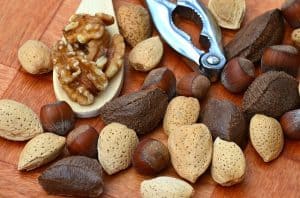
What are some examples?
Let’s focus back on what is Paleo – rather than what isn’t Paleo. Here’s some examples Paleo meal ideas. Keep in mind there are limitless variations on Paleo.
- Breakfast – Eggs, smoked salmon, and a banana
- Lunch – A large salad with olive oil and roast chicken, or shrimp
- Afternoon snack – a handful of nuts or seeds
- Dinner – Steak, broccoli, and carrots
The basic template is : meat (or fish or poultry), and vegetables, and fruit.
As you can see, there’s many Paleo meal options. You may already be eating in a Paleo style (and enjoying it), at least occasionally. Ever have scrambled eggs, bacon, and fruit for breakfast? That’s Paleo!
There are many, many books and websites dedicated to Paleo meal ideas, recipes, snacks, and even alternative “paleo bread”, “paleo pancakes”, and more.
Paleo by itself is relatively low carb, but a true ketogenic diet requires a minimal level of carbs to maintain ketosis. Paleo can be ketogenic – if you keep net carb intake to about 20-35 grams per day maximum.
What are the benefits of the Paleo diet?
A popular question: Is it Paleo? Google this, for any particular food item, and you may find a variety of answers. To be honest, we don’t truly know how our ancestors ate – that sort of information is not well preserved over time. And critics of Paleo use that as a counterpoint to the diet. But the more important point is understanding the general ideas behind this style of eating and interpreting your body’s reaction to certain foods. A better question might be: Does your body agree with this food?
Let’s recap the benefits of the Paleo style of eating:
- Low Carbohydrate – It is inherently low carbohydrate. Following Paleo eating principles you will avoid foods with high Glycemic Index (GI) or Glycemic Load (GL). This results in overall low Glycemic Load which means stable blood sugar levels, less dramatic roller-coaster energy levels, and positive impacts on blood triglyceride combinations. Insulin sensitivity is improved, because the body isn’t constantly being overworked and flooded with sugars and carbohydrates.
- Utilizing fat as an energy source – As mentioned earlier, along with increased insulin sensitivity (for proper handling of blood sugar) our bodies seem to recalibrate to utilizing both dietary fat, and body fat for energy when needed.
- Plentiful protein – Protein is an essential nutrient. Besides being the core structural component of every cell in the body, your body cannot function without the essential amino acids. Paleo eating provides plenty of opportunities for both animal and plant-based protein consumption. Protein also has significant thermic effects, because it actually requires a high level of energy to metabolize (when compared to carbs or fats).
- Elimination of potentially unhealthy preservatives – Seeking out natural, whole, and minimally processed foods means that preservatives and other questionable substances (such as food dyes) are eliminated. Why is eliminating preservatives important? As one example, cured meats made with preservatives such as nitrites are a known cancer-causing agent.
- Improved Omega-3 : Omega-6 fat ratios – Paleo eating provides for a more balanced ratio of Omega-3 to Omega-6 fats – this allows your body to better utilize the Omega-3s, and reap the rewards of these healthy fats.
- An abundance of natural sources of vitamins, minerals, and anti-oxidants – Through the intake of a lot of plant-based foods – both vegetables and fruits – your body will have an abundance of these important micronutrients, delivered in the form your body can utilize properly.
- High in fiber – Fiber, while not an essential nutrient, is still considered essential to proper health. It is an important component of proper digestive function. Despite what the food industry and government has been telling us for the last 25 years, whole grains are not the only source of fiber. Vegetables and fruits are an excellent source of fiber – and Paleo eating provides plenty of fiber because of this.
- Better gastrointestinal (GI) function – The Paleo foods are highly compatible with nearly everyone’s GI system.
Closely aligned with Paleo is the AIP diet – Autoimmune Protocol diet. The AIP diet is used to reduce inflammation in the body, and specifically in the gut and intestines. It is a popular choice for those suffering from an autoimmune disease. Because it builds upon the basics of Paleo, an AIP diet will be even more restrictive. For example, the “nightshade” fruits (Tomatoes, etc.) are typically not allowed. Autoimmune disorders affect over twenty-three million people in the United States each year.
And in our opinion, this is the real reason behind Paleo’s effectiveness. It’s a practical set of easy to understand rules that ultimately drive very healthy nutritional practices. It’s less important whether or not our ancient ancestors ate this or that particular item. It’s the end result that matters.

Combining the Paleo diet and exercise
Paleo is very popular with CrossFit enthusiasts. Much of the core principles are codified and endorsed right in the succinct definition of CrossFit provided by CEO and founder Greg Glassman: World Class Fitness in 100 Words.
Many of the Paleo diet theories also incorporate recommendations for physical activity – whether via exercise or simply the activities of everyday life. And while these recommendations do make a lot of sense logically, the truth is that Paleo style eating is highly compatible with many forms of exercise – and even a lack thereof.
Athletes and fitness enthusiasts are successful with Paleo eating principles in all the varied athletic and recreational endeavors – that includes endurance training, strength training, interval training, and the everyday activities of life.
In Summary
The principles of the Paleo diet encourage very healthy eating “best practices” – the fundamental principles on which diets for weight loss, weight maintenance, and general health are based.
Whether or not we fully understand what our ancient ancestors ate is somewhat irrelevant, as we can reap the benefits of improved diet through this philosophy.
Because Paleo facilitates these best practices (lowered carb intake, low GI/GL, high levels of fiber, vitamins, and minerals, and more) we endorse and recommend the Paleo diet.
To answer the question originally proposed: “Is the Paleo diet right for you?” We recommend you try it if you are eager to benefit from improved health, energy levels, and a healthy body composition. Perhaps more importantly, it will help you develop a sense for the food types that work for you.
Further reading
All of the following books provide an excellent, detailed rationale of the Paleo and evolutionary diet philosophy. They also elaborate on the biological processes that form the basis of how our bodies process food. All are highly recommended if you are interested in the details of how and why Paleo works.
- De Vany, “The New Evolution Diet: The Smart Way to Lose Weight, Feel Great and Live Longer.”
- Wolf, “The Paleo Solution: The Original Human Diet”
- Corden, “The Paleo Diet: Lose Weight and Get Healthy by Eating the Food You Were Designed to Eat”
References
- Fiolet Thibault, Srour Bernard, Sellem Laury, Kesse-Guyot Emmanuelle, Allès Benjamin, Méjean Caroline et al. “Consumption of ultra-processed foods and cancer risk: results from NutriNet-Santé prospective cohort” BMJ 2018; 360 :k322


Tim is the founder of FitAtMidlife.com – an avid gym rat for 30+ years, he’s a reviewer of many, many shoes – and founder of the Speed Bag Gathering – the world’s only gathering of speed bag punching enthusiasts. See more gym reviews at Tim’s YouTube channel.

